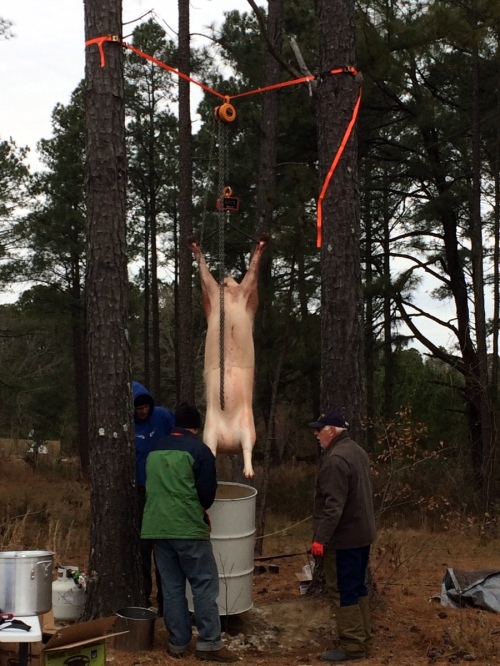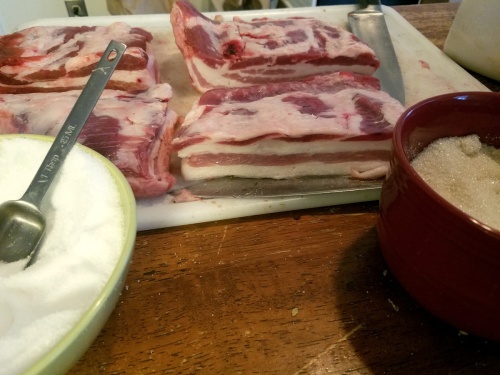So boudin noir is the French take on the German blutwurst which is the corollary of the Spanish morcilla, but in England it’s pronounced blood pudding. Kind of. Something like that. No matter the ethnic nuance you start with, it’s basically pigs’ blood mixed with some spices and some other stuff then cooked and eaten. I also think it has the greatest ick factor of all the weird things I’ve done in the past two weeks. Bottom line, though? It’s tasty. Just like head cheese and fried kidneys are tasty. It’s commonly agreed upon that Pork as a food group is good eating, but these other things that our culture has left behind take eating pork to a whole new level. The catch, of course, is that it’s kind of vital to have crazy fresh and super clean ingredients and that, well, means raising and slaughtering and butchering the pig yourself. Or trading your first born to someone who did raise the pig. As I like our son, we chose the first option. I would like to share with you one of the coolest things I’ve done thus far as a homesteader.
***Graphic pictures ahead, because…well…the pig had to die to make a transition. He went from pushy, greedy garbage disposal (who also enjoyed basking in the sun, letting me scratch his ears, and snooting up the ground with his snout) into food for my family. I liked him and knew his personality. There is loss but it’s loss with a purpose, so there you go. Blood and cutting is part of that transition. You’ve been warned***
I’d love to write a whole post just on our experience at a Pig to Plate workshop we attended two weeks ago in Ohio. Realistically, with Christmas in 3 days I’m impressed I’m getting this post done. To condense: best money we’ve spent on educating ourselves and regaining a connection with our most complicated dietary aspect…meat. Quinn and Bill Veon of Reformation Acres hosted, Andy and Doug from Hand Hewn Farm taught. It was truly life changing and I’ll be forever grateful for that change. They will be hosting more workshops and if you are ever remotely interested in home hog production…get thee to a workshop!
It really doesn’t matter if someone warns you about leaving the hose out the night before you need it. Most likely it will be left out and you will be grateful that as the guys at the workshop related their personal experiences with such an oversight…they also joked about a solution. Hence we ended up with about 120 feet of garden hose in our bathtub at 9 am. Stranger things have happened.
I got back from dropping off kids to hang out with grandma for the afternoon. This wasn’t because I was worried about them seeing the process, but because I knew I needed to be able to work hard without chasing munchkins. Eventually (probably next year) they will stick around. Anyways, we went into the yard and the pig stood still and just stared at Neil. Big Man (you can’t feed something twice a day for 7 months and not give them some sort of name) was shot and down and bleeding out…and it went crazy fast. It’s weird how the mind messes with time perception in high adrenaline situations. We realized later that we didn’t get a great bleed, but even with that, the shot was good and our boy died quickly and peacefully. Well. To an outside observer it wouldn’t actually look peaceful. When an animal dies their body has an awful lot of energy still running through it and so most will thrash around for a bit and with a big animal it can seem pretty violent. (Although the first rooster we killed, scared us so much with how much he thrashed, we nearly second guessed this whole farm thing all together) Death Throes are a real thing.
We had some guys from church come to help and we got the pig on a tarp to carry a few yards to our set up for scalding and scraping.

Getting an accurate weight was important to me so I can keep track year to year, and also to know our dress-out ratios.
Ok here’s what happens once you get the hog hooked onto the gambrel (back legs in the barrel first so you only have to flip once): it is dunked into warm water, 149ish degrees to be precise. This temperature allows the outermost layer of skin to loosen and the hair to start to loosen as well. It only takes a few minutes. Longer time or hotter temperature can actually set the hair, making scraping nearly impossible. I have it on good authority that shaving the whole carcass takes about 11 years.
After the proper dunk time you grab some back hair and see if it comes out easily. If it does, you hoist the pig out and start scraping. On our way home from Ohio we stopped at Lehmans, a store that actually carries tools for this scraping. They are called Bell Scrapers or Hog Scrapers. Unfortunately, they serve a large Amish community and it’s that time of year…they were out. We improvised with a coconut shell-er thing and a thing that was once a part of a lamp (I think) and it actually went really well. One advantage to our warmer southern winter…the dense winter hair hadn’t come in yet. The head and front trotters didn’t scald well so we didn’t use the trotters and Neil, being awesome, later poured boiling water over the head and cleaned it so that I could still use it. He is good stuff. Once the hair is scraped, you shave what ever is left, then blowtorch anything after that. Yeah, a working blowtorch would have been great…last minute Christmas gift to my husband?
Next is evisceration. Things to save and use/eat: small intestines (and large if you are feeling brave and masochistic), heart, liver, lungs, spleen, kidneys, and caul fat. Wait! What’s that? All that sounded familiar except the caul fat?

This, my friends, is caul fat and it’s culinary potential is nigh unlimited.
After you save the good bits and bury the bad bits, you remove the head and split the carcass with a bone saw so it can thoroughly chill. The weather could not have been more perfect for us. It took us about 3 hours from shot to getting ready to split so I had to run and rescue grandma. The kids were equal parts fascinated and disgusted. They were so disappointed that while I did save the bladder to blow up like a ball…I didn’t put it in its own container and it ended up covered in bile. Ain’t nobody touching nothing that smells that weird! And there we called it a night.
Day #2: Break it down now. Leaf lard came out first (top left). This is the stuff pie crust dreams are made out of and so it is treated with respect. Then we cut one half into primals outside. A hog is divided into 4 quarters or primal cuts. Then each of these is broken down further. At the workshop we got to practice this process on someone else’s pig, which made doing it on our own sooooooo much easier. Not saying we couldn’t have YouTube-ed it…it just would have been a horrific mess if we had. We brought in one quarter at a time. Our babies helped for a while and then peacefully destroyed the house while the adults kept at it. This day was long, but we managed…and it feels so great to have a freezer full of beautiful white packages.

Our work was not finished with all the fresh cuts being done…oh no.
Stock was made, lard was rendered, small intestines were turned into sausage casings which were in turn made into blood sausage (which i love, by the way).
During the next few days the madness continued.
Scrapple, Headcheese, Christmas Eve Ham put into brine, fried kidneys. And it all tastes so delicious. Offal is my new favorite ingredient…I must have some sort of mineral imbalance. 
Nearly 40 lbs. of bacon is a strong argument for raising your own pork. We finished packing the ground pork today, it still will be turned into various typed of stuffed sausages. 
I’ll be happily nibbling headcheese and rillettes for the next two weeks while we celebrate the holidays.
Final counts and thoughts:
- Live weight – 365 lbs.
- Hung weight – 281 lbs.
- 124 lbs. fresh cuts including ribs
- 38 lbs. bacon
- 45 lbs. ground pork
- 9.5 quarts lard
- 4 gallons stock
- 11 lbs. scrapple
- 4-5 lbs. head cheese
- 5 half pints rillettes
- lots of lbs. of liver, kidneys, heart, and spleen. (all of which have been used)
- 60 feet of sausage casings and caul fat (going to become Crepinettes on Christmas Eve and roast rabbit once I have rabbits in the freezer)
- skin (not finished with this so don’t have a total. Doesn’t matter, we have enough to make cinnamon sugar pork rinds and change the world one mouth at a time)
It was an incredible experience and I wish I could write more. Oh wait I can! We are doing this whole thing again in a few months when we process our girl! There are big plans for her given our success this time round and I will probably write all about how my life and the life of my family has been changed forever by doing this. That sounds melodramatic, I know. But seriously, now that I’ve started to take more control over what I eat and had a taste of the satisfaction it brings…I’m not sure I could ever not being doing this. Don’t know that I have a choice anymore and that makes me happier than I can say.





















I give you credit for trying so many new foods. Know I would not be eating any blood pudding, head cheese or fried kidneys. But glad you enjoyed them.